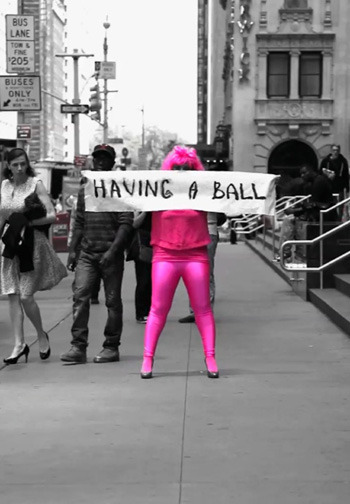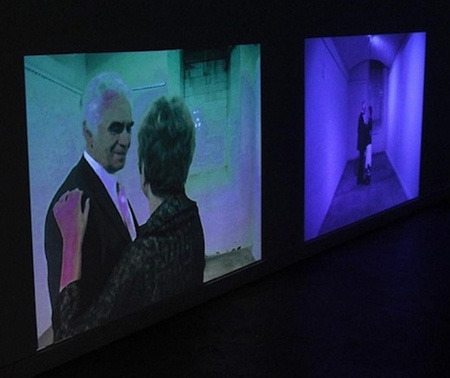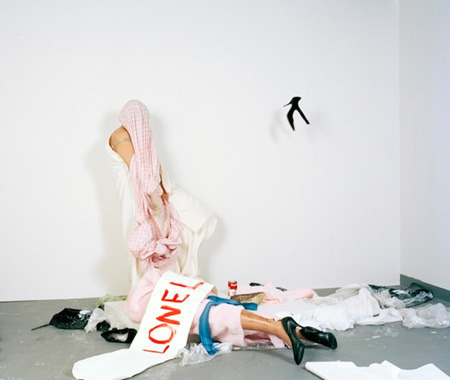Meet A NYFA Artist: Katya Grokhovsky
Katya Grokhovsky, Selfie as an artist with mask, mixed media, 2013
NYFA speaks to Katya Grokhovsky (NYFA Immigrant Artist Mentee, 2012) about matters including: her interdisciplinary work; her current solo exhibition, Bodybeautiful, at Galerie Protege; her piece in NYFA’s exhibition at the Governors Island Art Fair this September; and her experience as an immigrant artist.
NYFA: Your work often confronts issues of identity, feminist theory, politics, and culture. What has been the most rewarding aspect of confronting these issues?
KG: These particular issues, in their broadest sense, have always been crucial to my development as an artist, as a human being, and as a woman. The most rewarding aspect of working with the subjects I believe in has been an ability to zoom in on various sides of them and to take bold stances through my artwork, which I otherwise might not have done on my own without the platform of my art.
I tend to explore these themes via rigorous material experimentation process and ongoing research and find it highly beneficial to be open to chance encounters, accidental findings and failures, whilst maintaining a specific point of view. As an artist, I try to consistently stay both playful and serious in my work, a somewhat contradictory process in itself, albeit a highly rewarding one, which often leads me down absurd pathways. I also never lose my sense of humor. It is extremely important to me and my work and has guided my survival as a nomadic artist.
NYFA: In your work, you use a variety of materials, sometimes even performing in pieces yourself. In what ways do you intend your audience to interact with your work — what kind of experience do you hope they will have?
KG: I prefer my audience to walk away with more questions than answers. My work has received various reactions including anger, confusion, misunderstanding, laughter, compassion, bewilderment and even pity. I welcome all. Whether the work is designed to be specifically directly interactive or not, I attempt to open up conversations, often confusing and on difficult subjects, such as intimacy, male privilege, body image, sex trafficking, gender and culture stereotypes, migration and displacement. However, although the experience of my audience is important and often integral to my practice, it is never a direct reason I make work. Instead, I generally do not try to predict how the public will react to my art, but intend the work to be both open to interpretation and have specific meanings – a difficult balance to maintain. I am the kind of artist who learns by doing and I often discover new meanings long after the work is completed and through what other people have found in it. So, in a way, my own work and its audience are my teachers. It is a challenging way to practice, but is often an exciting and surprising one. However, I am partial to my favorite reactions and experiences, such as a smile, a puzzled expression and a heap of relevant questions. Let’s discuss!
I do want to know what you feel when you see me basically embarrass myself, especially in my performance work as I endure pain, whilst wearing impossibly high heels and walking around carrying banners for a long time, or when I ask strangers to slow dance with me, facing constant rejection.
I imagine my audience sympathizing with my aching body, whilst I durationally dance the part of a male Ukrainian folk dance or sing old Russian songs, or walk around in sight-obstructing costumes trying to interact with my environment for hours on end.
One of my first performance works in NYC was in 2008, when I came here for three months to intern at Franklin Furnace Archives. I basically cried durationally for three hours in public, allowing the audience to be positioned very close to me, to watch me, to touch me, to console me. I learned a great deal about audience interaction right there and then, especially being a new transplant to the city.
My own limits, abilities and boundaries have been tested then and I aspire to keep doing that, as my work develops and becomes more complex and layered over the years. I treasure those moments in my work, which keep me on my toes and push it forward, as well as the unexpected reactions, the new experiences, the open-ended dialogue.

Katya Grokhovsky, Status Update, performance for video, video still, 2013
NYFA: You participated in the 2012 NYFA Immigrant Artist Mentoring Program. What effect did the program have on your work?
KG: I think the project was a great way to enter NYC post MFA. It has without a doubt helped me to position myself as an artist within New York City specifically, but also in the USA at large. I began thinking about my place here and what it means to live and work in a city so rich with art history and international culture, and to be surrounded by practicing artists. I discovered I had to have a new mindset and to reboot my thinking, which in turn, has affected my way of practicing and ultimately, my work in ways I couldn’t foresee on my own.
For example, as essentially an interdisciplinary artist, I used to constantly think and waste a great amount of time on my anxieties about what my story is: am I a sculptor, a performance artist, a painter, video artist, photographer, I also draw, I collage and I write? Now, I see my practice as one large fertile playground full of possibilities, rather than a space of worrying about labels, limits and market demands.
NYFA: You are an immigrant and have lived in several countries throughout your life. What has been the most challenging aspect of this experience, and how has it impacted your work?
KG: I believe one of the most challenging aspects of any displacement is the loss of your own identity and a sense of belonging, which happens every time, without fail. However, as much as it has not been an easy task to live in places from which I originally do not come, it has clearly made me an extremely adaptable artist.
I am light on my feet, so to speak, and despite my passion for collecting found objects and acquiring new materials everywhere I go, I have been able to practice in new environments easily, learn new techniques and jump into new disciplines all the time, whilst disregarding my fears of failure and incompetency. Those fears have never stopped an immigrant, and I use that ability to evolve and adapt in my practice. Learning a whole new language is akin to learning a whole new discipline, and I have never forgotten that.
The geographical movements throughout my life have shaped my character and personality in many ways and allowed my practice to change accordingly. Specifically, loss and displacement are major themes I research, often mining my own experiences. I do feel like I have had many lives, and often don’t particularly know who I am, or where my home is, but this feeling of “unbearable lightness” enriches my practice to no end and fuels my fire to investigate often uncomfortable, painful issues.
Migrating first from Ukraine to Australia as a 15-year-old girl has taught me a great deal about human nature. In the process of learning a new language and culture, I used to observe body language obsessively, learning to read peoples’ faces and gestures before I could understand them verbally. I often try to capture that liminal space in my work. That space, so important to an artist, is a space of the in-between and discomfort, of losing one’s own primary culture and language, and gaining a new other.

Katya Grokhovsky, Slow Dance (parents), two-channel video installation, 2012
NYFA: Congratulations on your first solo exhibition in New York at Galerie Protege. How did you approach the show, and what can viewers expect to see?
KG: Thank you so much, it has been quite a learning process. The exhibition has been in the works for almost a year and has gone through many changes. I called the show Bodybeautiful, which is a title I came up with first for a class for an imaginary solo exhibition in New York during my undergraduate degree at Victorian College of the Arts in Australia, after I cut my then long hair off in a live action.
I kept that handmade, photocopied invite throughout my travels, and I still have it in my studio to this day, forgive my sentimentality, as a reminder of a woman who dared to dream. I decided to keep the title, because it fits the ideas of my current work perfectly. The title itself was culled from beauty magazines, which I was always collecting and obsessing over as a young girl.
So my approach from the very beginning was to show a diverse variety of works in many mediums, focusing around the theme of the body image and the ridiculous in the feminine existence. I usually produce a lot of work, showing often only a fraction and sometimes have difficulty choosing what to show, so to aid this process, I asked Peter Gynd, a curator with whom I have been working for almost two years now in NYC, to curate and select the specific works.
The exhibition presents collages, made with beet juice, an installation with found objects, post-performance sculpture-ephemera, a video installation, comprising of performances for video, created on site at the gallery and a live performance (on October 3rd). Most of the work was produced whilst I was an artist in residence at NARS in Brooklyn, where I was able to widely experiment.
The title can be somewhat misleading, which is my intention, as the viewer is lead into the world of somewhat grotesque, as well as beautifully absurd world, as opposed to the expected space of standards.
NYFA: In addition to that exhibition, you are participating in NYFA’s exhibition in the Governors Island Art Fair. Can you tell us about your work in that show?
KG: The work in this show comes from an ongoing photographic series, which I called House Portraits, and which I began making whilst being a graduate student at The School of the Art Institute of Chicago in 2010/11. The particular photograph in the show is a shot of a ceiling of a kitchen in a house in Oak Park in Illinois, which was a gallery called What it is and where I showed the first photographs of the series.
As in the NYFA exhibition, the photographs were intended to be shown in the space itself or a space similar to the one where they were first taken, sort of double exposing the reality, or as art mirroring life and vice versa. So the particular space of an old house at Governors Island Art Fair suits the work very well.

Katya Grokhovsky, Untitled Heroic, performance for photo, credit: Andrew Green, 2011
NYFA: Any new materials/mediums that you’re excited to experiment with this fall?
KG: Yes, I often have several projects developing at the same time, and this fall I am obsessed with masks and am working on large scale sculptures and performative objects, playing with various new materials such as resin and silicone rubber, casting and mixing with found objects, plaster, house paint, textiles and embroidery.
I am also eager to start working extensively with voice and sound in my performance work, which I have not previously explored much, due to “accent insecurities” and fear of public speaking. I decided to test these fears finally and see what I can create using my writing, which has always accompanied my practice and has been mostly personal, except for a few blog projects. I have basically started compiling my numerous texts into a book, which I have always wanted to do and never had the guts or time to accomplish. I am terrified, but it is a brave new world and I am giddy with excitement.
NYFA: What advice would you give to other artists living in foreign countries or cultures?
KG: I guess the advice I would give, before moving or deciding to practice anywhere new and foreign, is to test the waters and get involved in the local community of artists in any way you can. I especially recommend residencies and various cultural local programs for that purpose, as they help build a network of artists very fast, specifically the ones where you live onsite. Education of course is another great way to dive into a foreign culture and ground yourself, but as that can be expensive and unattainable, I would seek communities through volunteering, interning or…create one yourself!!
I strongly believe it is important to have the guts to do things yourself and not wait for anyone to tell you what you should be doing as an artist, not to always be a blushing bride-to-be-in-waiting. It never truly works that way anyway. Start something up, use your apartment, your studio, do one night events, etc, it all helps. I started doing that almost as soon as I moved to USA and in NYC I have an ongoing project, called The Bedroom Gallery, through which I put together occasional one night party-exhibition-events, starting out in my apartment and now going to other venues. I have managed to meet a lot of new people this way.
Moving to a new place can be quite an exciting adventure, and it should be, but it can also be an extremely alienating and life-altering experience. I never underestimate the importance of adopting a new culture; I guess immigration taught me that.
Plan ahead, do your research, learn the rules, break the rules and always trust your instincts. Most importantly, ignore your fears of the unknown: basically, be brave, just do it! Every time, it feels as if you are learning to swim again and the only thing to often do is jump right into those deep waters!
— Interviewed by Katherine Booth
For more information on Katya Grokhovsky, visit her website or check out her blog. For information on her current exhibition, visit Galerie Protégé.
The Governors Island Art Fair takes place every Saturday & Sunday in September. NYFA’s exhibition is in Building 4A, Nolan Park.



